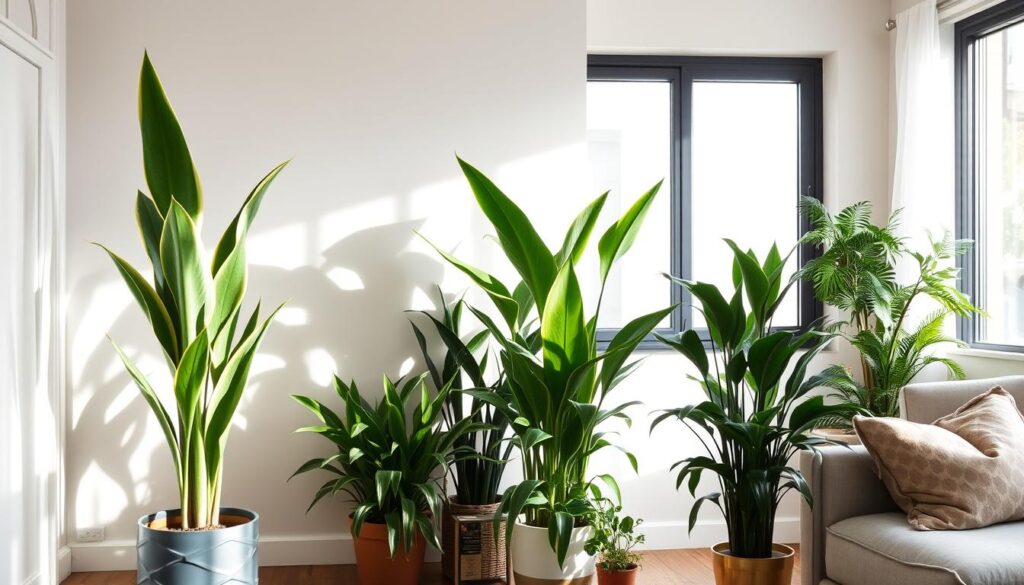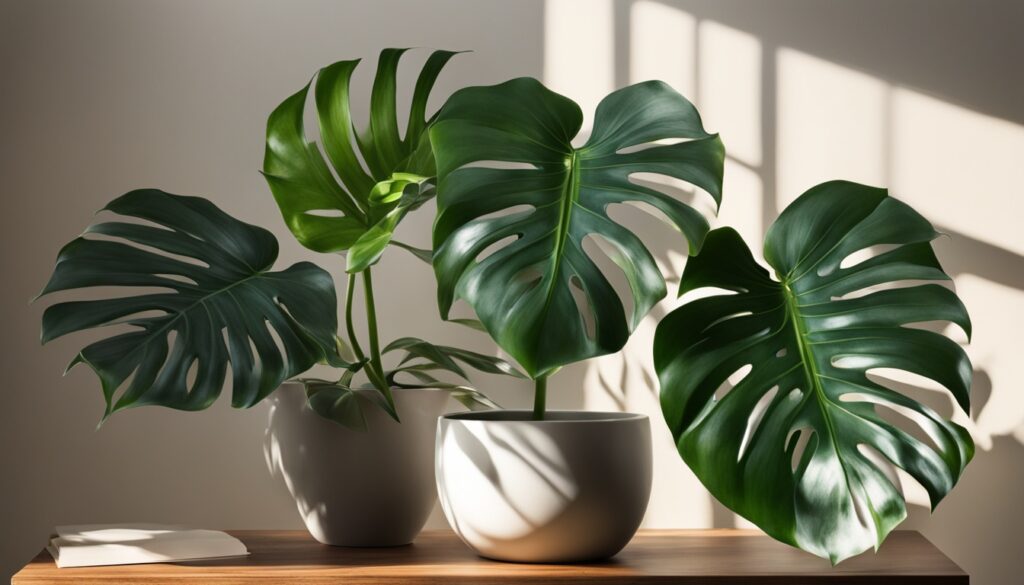Are you looking for the perfect tall houseplants for your dimly lit home corners? You’re in the right place! We’ve got a stunning collection of plants that love low light. They’re perfect for making your indoor spaces look amazing.
From the famous snake plant to the stunning Monstera deliciosa, these plants are here to change your home. They’ll make your living space look and feel better.
Key Takeaways
- Discover a variety of tall houseplants that can thrive in low-light conditions
- Learn about the unique characteristics and care requirements of each plant
- Explore the benefits of incorporating tall indoor plants in dim spaces
- Understand the importance of selecting the right plant for your specific lighting conditions
- Discover expert tips for maintaining the health and growth of your tall low-light houseplants
Understanding Low Light Conditions for Indoor Plants
When growing low maintenance vertical plants and oversized shade-loving houseplants indoors, knowing about low light is key. Low light means areas that get little direct sunlight. This includes spots away from windows or rooms with north-facing exposures.
What Qualifies as Low Light
Low light is defined by a photosynthetic photon flux (PPF) of 50-150 µmol/m²/s. It’s also 50-250 foot-candles or 10-15 watts. You can find this in corners, hallways, or places blocked from direct sunlight. Even though some plants can handle low light, they might not grow well.
Measuring Light Levels in Your Space
To check your indoor space’s light, use a light meter or a smartphone app. These tools measure light intensity. Knowing this helps pick the right low maintenance vertical plants and oversized shade-loving houseplants for your space.
Impact of Light on Plant Growth
Enough light is vital for plants to grow and develop. Low light slows growth, makes leaves less vibrant, and can cause leaves to fall off. Plants may lean towards the light they have. Knowing what light your plants need is important for their health and growth.
Benefits of Growing Tall Plants in Low Light Areas
Adding tall indoor plants for dark corners and vertical greenery to dimly lit spaces has many benefits. These plants make a room look better and also improve its health. They help make the space and its people feel better.
One big plus of tall plants in low light is how they clean the air. Plants like the snake plant can remove bad stuff from the air, even without sunlight. This is great for places like bedrooms and offices where people spend a lot of time.
Also, having tall plants in dark corners can boost your mood. Research shows that plants can lower stress, make you feel happier, and help you relax.
| Plant | Height | Light Requirements | Air Purification |
|---|---|---|---|
| Snake Plant (Sansevieria) | Up to 120 cm | Tolerates low light | Excellent air purifier |
| ZZ Plant (Zamioculcas zamiifolia) | Up to 90 cm | Thrives in low light | Effective air purifier |
| Umbrella Tree (Schefflera) | Up to 240 cm | Tolerates bright indirect light | Good air purifier |
Moreover, tall plants can make a room feel bigger and more interesting. By adding vertical greenery to dark spots, you can turn a dull area into a lively spot. This adds a natural touch to your space.
“Bringing nature indoors through tall, lush plants can have a profound impact on the ambiance and energy of a space, even in areas with limited light.”
In summary, growing tall indoor plants in dark corners offers many benefits. These include cleaner air, better mood, and a more beautiful space. By choosing plants that do well in low light, you can make even the darkest areas bright and welcoming.
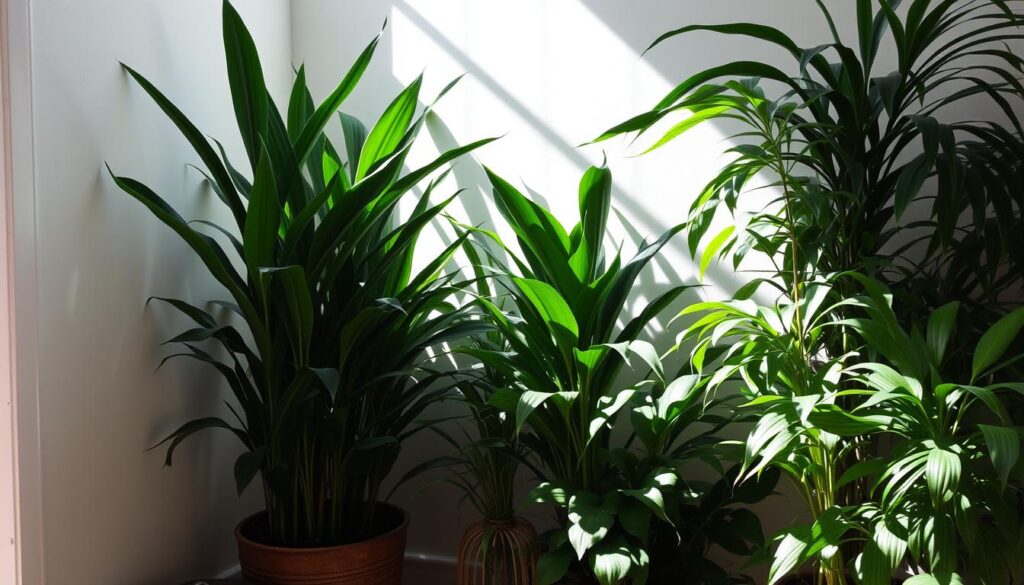
Essential Care Tips for Low Light Indoor Plants
Cultivating low maintenance vertical plants or tall houseplants for shady areas can make any dimly lit corner lush and vibrant. But, it’s key to give them the right care for them to do well in low light. Here are the essential tips to keep your indoor plants healthy and happy.
Watering Requirements
Low light plants need less water than those that love the sun. They grow slower, so they don’t need as much moisture. To avoid overwatering, let the soil dry out a bit before watering again. Watch the soil’s moisture and adjust your watering schedule as needed.
Humidity Needs
Some low light plants, like calathea and triostar, like it more humid. Place these in bathrooms or kitchens where it’s naturally more humid. Or, use pebble trays to add moisture around them.
Fertilization Schedule
Fertilize low light plants lightly because they grow slower. Use a light feeding schedule, usually during the growing season. This gives them the nutrients they need without overwhelming them.
“The key to success with low light indoor plants is to understand their unique needs and adapt your care routine accordingly. By striking the right balance, you can create a lush, thriving oasis in even the darkest corners of your home.”
Keep these care tips in mind to grow a stunning collection of low maintenance vertical plants and tall houseplants. They’ll thrive in shady areas, adding natural beauty to your home.
Snake Plant: The Ultimate Low-Maintenance Choice
The snake plant (Sansevieria) is a top pick for tall low light houseplants. They can grow well in almost any light, even full shade. This makes them perfect for dark corners. They can grow up to three feet tall, adding height to your space.
Snake plants are very easy to care for. They need water only when the soil is dry. They also clean the air, making them a great choice for homes. But, they are toxic to pets, so keep them away from furry friends.
| Plant | Average Height | Light Requirement | Price Range |
|---|---|---|---|
| Snake Plant | 2-4 feet | Indirect light | $33.00 – $186.00 |
| ZZ Plant | Up to 3 feet | Indirect light | $35.00 – $195.00 |
| Devil’s Ivy | Up to 18 inches | Indirect light | $18.00 – $68.00 |
Snake plants are perfect for those who want plants that don’t need much care. They thrive in low light and can brighten up any dark corner of your home.
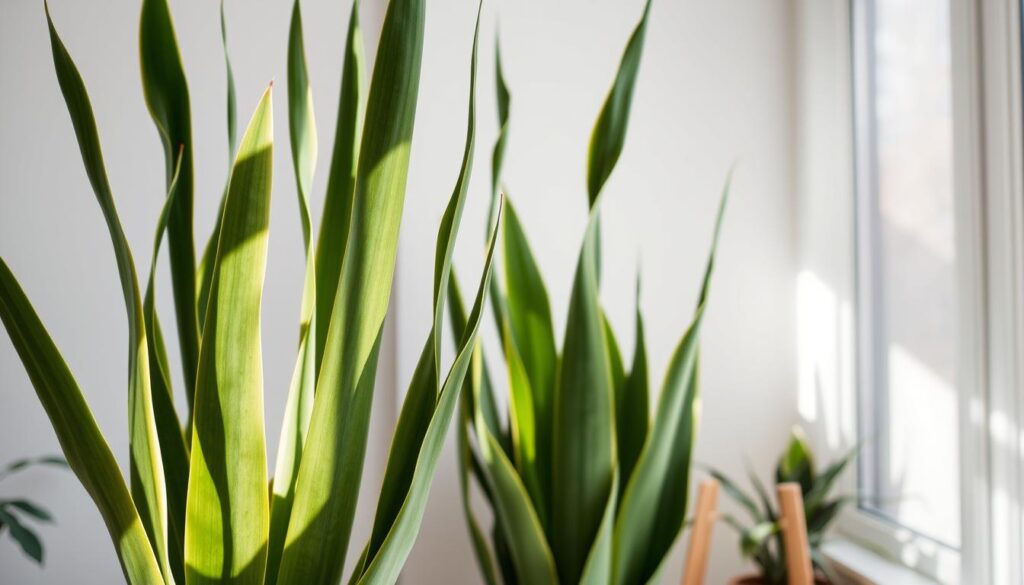
“Snake plants are available in more than 70 species and numerous cultivars, making different varieties common at local garden centers or online.”
ZZ Plant: A Resilient Beauty for Dark Corners
The ZZ plant (Zamioculcas zamiifolia) is perfect for dark corners. It’s low-maintenance and grows well in dim light. This plant comes from eastern Africa and is loved for its beauty and ability to adapt.
Growth Patterns and Characteristics
The ZZ plant grows slowly, reaching 3 to 5 feet tall. Its glossy, green leaves stand upright, adding beauty to any room. It stores water in its rhizomes, making it great for low-light and neglect.
Air Purifying Properties
The ZZ plant also cleans the air. Studies show it’s top at removing pollutants like nitrogen dioxide. It’s a great choice for homes and offices.
Care Instructions
Caring for a ZZ plant is easy. It likes medium to bright, indirect light and needs water every two to three weeks. Use a cactus or succulent mix for the soil. Fertilize twice a year with a balanced, diluted fertilizer.
But, ZZ plants are toxic to pets and kids. Keep them away from curious mouths.
ZZ plants are great for tall indoor plants for dark corners or low maintenance vertical plants. They’re easy to care for, clean the air, and look beautiful.
https://www.youtube.com/watch?v=iE_kYyw_oUw
Tall Low Light Houseplants: Popular Varieties
Looking for the right plants for your dimly lit spaces? There are many tall, low light houseplants that fit the bill. They add height and interest, and they do well in low light, which is common in many places.
The Dracaena family is a top pick. They can grow up to 6 feet tall and have beautiful leaves. The snake plant, for example, can grow 12 to 36 inches tall and handle different light levels. Learn more about the snake plant here
The Monstera deliciosa, or Swiss cheese plant, is another favorite. It has big, holey leaves that can grow up to 3 feet wide. It loves medium to low indirect light, making it perfect for dim rooms.
- Cast Iron Plant (Aspidistra): This plant can handle low light and grow up to 3 feet tall.
- Philodendron: There are many Philodendron types, including heart-shaped and vining ones, that do well in low light.
- Umbrella Tree (Schefflera): These plants can grow up to 6 feet tall and handle partial shade.
- Rubber Plant (Ficus elastica): With its big, shiny leaves, the Rubber Plant can grow up to 10 feet tall and prefers indirect light.
These plants not only make your space look better but also clean the air. They’re a smart and stylish choice for any room.
| Plant | Mature Size (Height x Width) | Light Needs |
|---|---|---|
| Snake Plant (Dracaena trifasciata) | 12 to 36 inches tall x 6 to 36 inches wide | Tolerates low light conditions |
| ZZ Plant (Zamioculcas zamiifolia) | 3 to 5 feet tall x 2 to 3 feet wide | Thrives in low light |
| Monstera Deliciosa | Up to 3 feet wide | Prefers medium to low indirect light |
| Cast Iron Plant (Aspidistra elator) | 2 to 3 feet tall x 1 to 2 feet wide | Tolerates low light conditions |
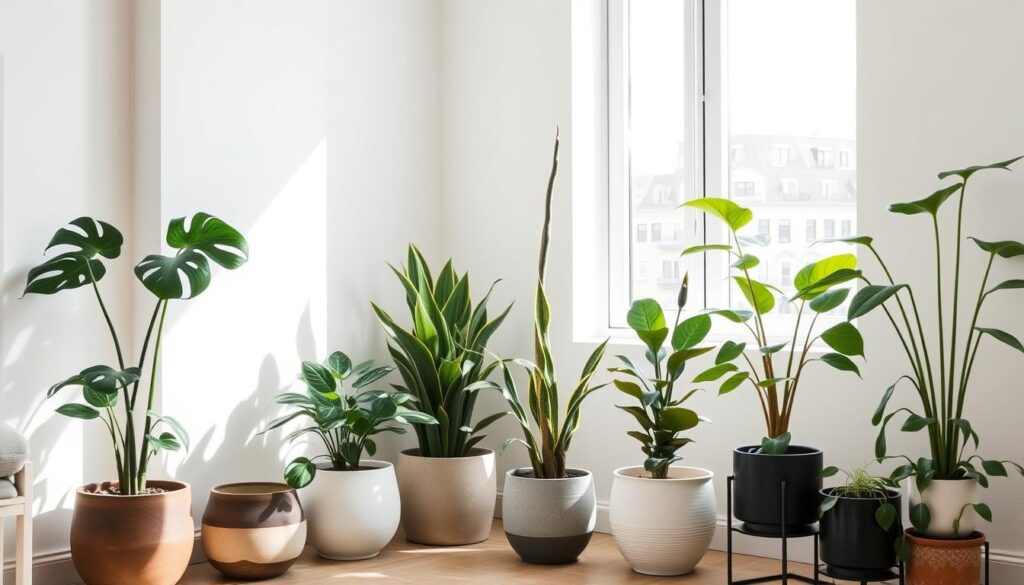
Adding these plants to your space can make it look lush and striking, even in dim areas. They’re great for both experienced and new plant lovers. These plants offer many ways to add height, texture, and clean air to your home or office.
Dracaena Family: Versatile Indoor Trees
The Dracaena family includes many tall houseplants that do well in low light. They are perfect for shady spots in your home or office. These “indoor trees” can grow up to 6 feet tall, adding a striking vertical element to your living spaces.
Different Dracaena Varieties
Some popular Dracaena species for indoor use include the Corn Plant (Dracaena fragrans) and the Dragon Tree (Dracaena marginata). These plants are loved for their unique leaves and ability to clean the air. They help remove harmful toxins like benzene, formaldehyde, and carbon dioxide.
Growth Requirements
- Dracaenas do well in bright, indirect light but can handle lower light too. They’re great for shady areas.
- They like well-draining soil and can go without water for a bit. But, they should be watered regularly to keep the soil moist.
- These plants are tough and easy to care for. They’re perfect for busy people or those new to indoor gardening.
Even though Dracaena plants are hardy, they are toxic to pets if eaten. So, keep them away from curious cats and dogs.
| Dracaena Variety | Height Potential | Lighting Needs | Pet Toxicity |
|---|---|---|---|
| Dracaena Fragrans (Corn Plant) | Up to 6 feet | Bright, indirect light | Toxic to cats and dogs |
| Dracaena Marginata (Dragon Tree) | Up to 6 feet | Bright, indirect light | Toxic to cats and dogs |
Adding these tall, low-light houseplants to your decor can make your space more interesting. They purify the air and create a lush, welcoming atmosphere. Even in shady areas, your home or office can feel lush and inviting.
Monstera Deliciosa: Dramatic Foliage for Dim Spaces
The Monstera deliciosa is famous for its unique split leaves. It thrives in low light, making it perfect for indoor spaces. This plant can climb or trail, fitting well in many settings.
Monstera deliciosa grows faster in bright light but still does well in dim places. It’s great for tall low light houseplants or large shade plants. It adds a dramatic, jungle-like feel to your home.
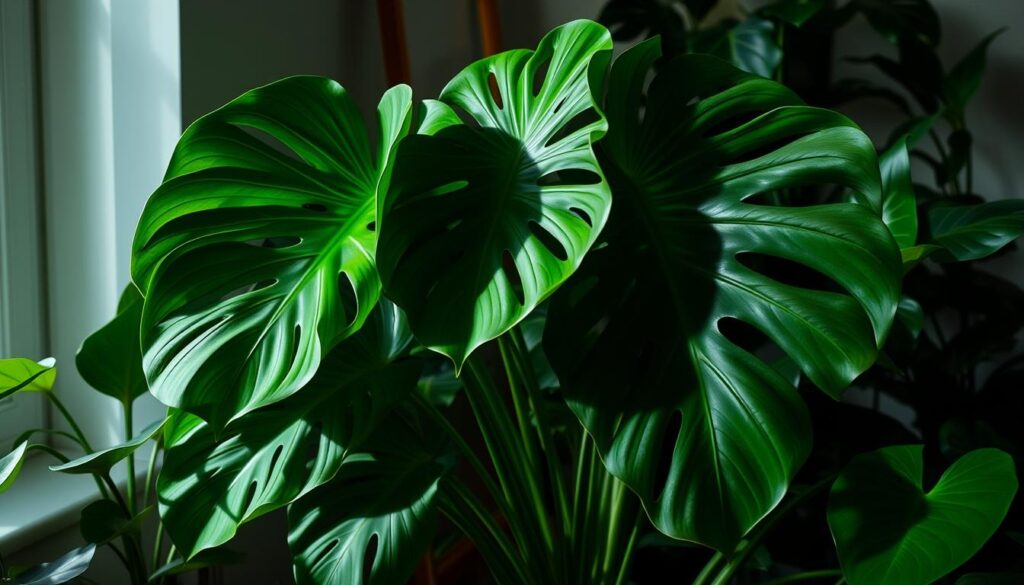
Monstera deliciosa is easy to care for but is toxic to pets if eaten. So, it’s crucial to keep it out of reach of pets.
“Monstera deliciosa is a true showstopper that can thrive in dim corners, adding a touch of the exotic to any indoor space.”
Monstera deliciosa is perfect for both new and seasoned plant lovers. It brings natural beauty and happiness to your home.
Cast Iron Plant: Living Up to Its Name
The Cast Iron Plant (Aspidistra elatior) is a top pick for dark corners. It’s known for its toughness and ability to grow well in low light. This makes it perfect for those who don’t have much time to care for plants or have little natural light.
Durability Features
The Cast Iron Plant has dark green, shiny leaves that can reach 2-3 feet tall. It’s famous for its ability to handle low light and irregular watering. Even in the darkest spots, it keeps growing strong. It’s a great pick for tall indoor plants for dark corners and low maintenance vertical plants.
Placement Options
- The Cast Iron Plant fits well in many places, from tall displays to small tables.
- It’s safe for homes with pets or kids because it’s non-toxic. This makes it a great low maintenance vertical plant.
- It’s perfect for adding green to dark areas like bathrooms, cozy reading spots, or modern kitchens. It makes any space look better.
“The Cast Iron Plant is the ultimate choice for those seeking a resilient, low-maintenance tall indoor plant that can withstand the challenges of low-light conditions.”
The Cast Iron Plant is a top choice for dark corners. It’s easy to care for and can handle poor light. Its toughness and flexibility make it a great addition to any home. It brings life and calm to even the darkest areas.
Parlor Palm: Classic Victorian Choice
If you’re looking for tall houseplants for shady areas or greenery for dim spaces, the Parlor Palm is perfect. It’s been a favorite since the Victorian era. And for good reasons.
Parlor Palms can reach up to 4 feet tall indoors. They’re great for any low-light corner. They need regular watering when the top inch of soil is dry. Plus, they’re safe for homes with pets because they’re non-toxic.
“Parlor Palms have been popular houseplants since Victorian times, and their low-maintenance nature and air-purifying abilities make them a great choice for modern homes.”
NASA says Parlor Palms are air purifiers. They help remove harmful toxins and improve air quality. This makes them a top pick for anyone wanting tall houseplants for shady areas or vertical greenery for dimly lit spaces.
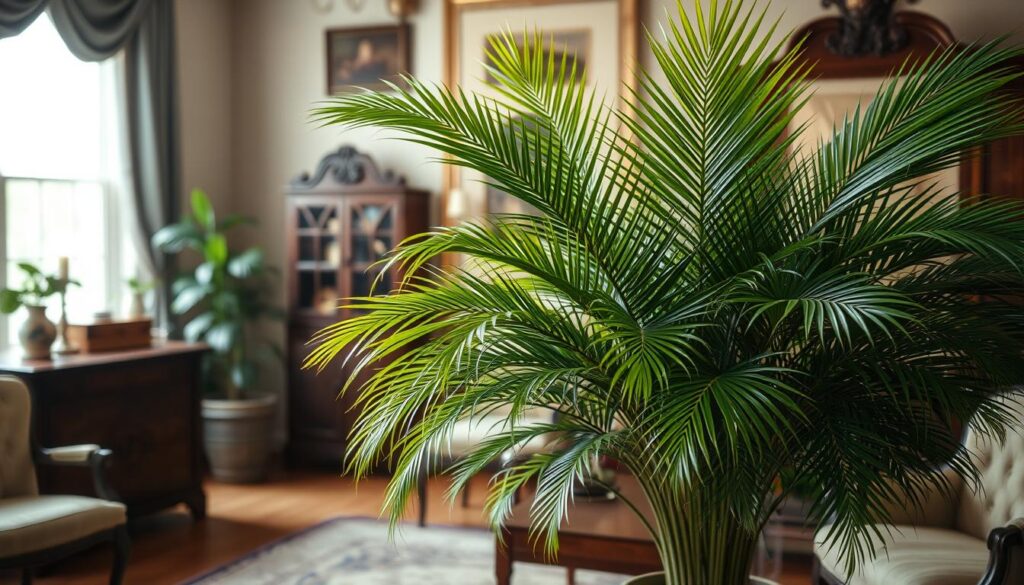
The Parlor Palm is perfect for decorating a cozy room or brightening a dim office. It adds natural elegance to any space. Its timeless appeal and air-purifying abilities make it a versatile, easy-care choice.
Rubber Plant: Bold and Beautiful
Rubber plants, known as Ficus elastica, are stunning indoor trees that grow well in low light. They can grow up to 8 feet tall indoors with proper care. This makes them a favorite for those looking for tall low light houseplants to enhance their spaces.
Even though rubber plants like bright indirect light, they do well in lower light too. Their big, shiny leaves make a bold statement and also clean the air. This makes them a great choice for any indoor plant collection that thrives in low light.
| Rubber Plant Characteristics | Key Facts |
|---|---|
| Growth Potential | Up to 10 feet tall indoors |
| Light Requirements | Bright, indirect light, can adapt to low light |
| Watering Needs | Water every 1 month, avoid overwatering |
| Toxicity | Classified as Class 4 on the toxicity scale, toxic to pets if ingested |
Even though rubber plants are easy to care for, they are toxic to pets if eaten. With the right care and precautions, these large houseplants that thrive in low light can add tropical beauty and clean the air in any indoor space.
“Rubber plants are a bold and beautiful addition to any low-light indoor space, offering both style and function.”
Creating Vertical Interest with Climbing Plants
To add height and visual intrigue to dimly lit corners, consider incorporating tall indoor plants that climb. Pothos, a hardy and adaptable plant, can be trained to grow vertically. This creates lush, cascading displays of vertical greenery for dimly lit spaces.
Using moss poles, trellises, or wall-mounted supports, you can guide the growth of these trailing vines. Regular pruning and redirecting of the stems help maintain a desired shape and height.
Training Methods
Freestanding trellises are ideal for larger plants that require substantial support. Wall-mounted trellises are perfect for creating vertical gardens in small spaces. Lattice trellises provide a grid-like structure that plants can easily climb.
Obelisk trellises, with their tall, narrow pyramid shape, add an elegant touch to indoor gardens.
Support Structures
In addition to trellises, you can use other support structures to guide the growth of your climbing plants. Pothos, English Ivy, Philodendrons, and Monstera Adansonii (Swiss Cheese Plant) are all well-suited for vertical displays.
Position these tall indoor plants for dark corners in strategic locations. For example, a freestanding trellis in the living room, a wall-mounted trellis with herbs in the kitchen, or a minimalist wire trellis with a pothos or philodendron in the bedroom. This adds a touch of natural beauty to your space.
| Plant | Ideal Lighting | Growth Habit | Recommended Support |
|---|---|---|---|
| Pothos | Full shade to bright light | Trailing, can be trained to climb | Moss pole, trellis, or wall-mounted support |
| English Ivy | Partial shade to bright light | Fast-growing, climber | Trellis or wall-mounted support |
| Philodendron | Partial shade to bright light | Trailing, can be trained to climb | Moss pole or trellis |
| Monstera Adansonii | Bright, indirect light | Climbing, vining | Sturdy trellis or moss pole |
By incorporating these tall indoor plants for dark corners and using various support structures, you can create visually captivating vertical displays. These displays add depth, texture, and a lush, jungle-like atmosphere to your indoor spaces.
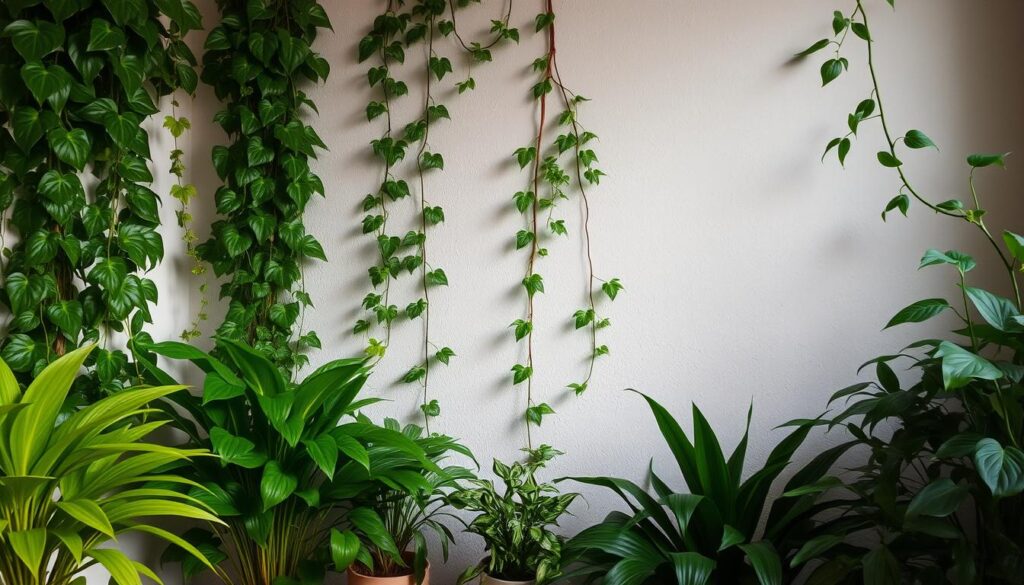
Common Problems and Solutions
Maintaining low maintenance vertical plants and tall houseplants for shady areas can be tricky. But, knowing how to solve common problems can help keep your indoor space beautiful. Let’s look at some common issues and how to fix them.
One big problem is leggy growth. This happens when plants stretch out too much, looking weak. To stop this, make sure to water them right and clean their leaves often. Pruning can also help them grow fuller and stronger.
Another issue is leaf drop. It can be due to too much water, pests, or stress. Keep an eye on how wet the soil is and adjust your watering. Also, check for pests and treat them quickly with neem oil or insecticidal soap.
| Common Problem | Possible Causes | Solutions |
|---|---|---|
| Yellowing Leaves | Overwatering, underwatering, excessive light exposure, pests | Adjust watering, reduce light, inspect for and treat pests |
| Leaf Drop | Stress, overwatering, pests | Monitor moisture, inspect for and treat pests |
| Discolored Leaf Tips/Edges | Humidity issues, salt/mineral buildup, inconsistent watering | Maintain proper humidity, flush soil, adjust watering |
| Distorted Growth | Pests, diseases, compacted soil, inadequate lighting | Identify and treat pests/diseases, loosen soil, provide appropriate lighting |
Knowing the common problems and their causes helps you fix them. With a bit of effort and the right care, your indoor space can stay beautiful and healthy.
Conclusion
Tall low light houseplants are great for adding greenery to dark indoor spots. Plants like the snake plant and the monstera fit many tastes and skill levels. They improve air quality, cut down on pollutants, and make your space more beautiful.
Knowing what each plant needs is crucial, whether you’re new or experienced. Choose the right plant for your space and follow the best care tips. This way, even the darkest corners can bloom.
Adding these plants to your home or office does more than just look good. They also make the air cleaner and bring peace. Let these plants brighten and refresh your indoor world.
